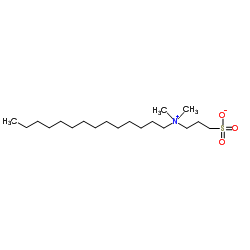Effects of detergents on the secondary structures of prion protein peptides as studied by CD spectroscopy.
Yoshihiro Kuroda, Yoshitaka Maeda, Shinichi Sawa, Kiyohiro Shibata, Kazuhide Miyamoto, Terumichi Nakagawa
Index: J. Pept. Sci. 9(4) , 212-20, (2003)
Full Text: HTML
Abstract
Pathogenic prion proteins (PrP(Sc)) are thought to be produced by alpha-helical to beta-sheet conformational changes in the normal cellular prion proteins (PrP(C)) located solely in the caveolar compartments. In order to inquire into the possible conformational changes due to the influences of hydrophobic environments within caveolae, the secondary structures of prion protein peptides were studied in various kinds of detergents by CD spectra. The peptides studied were PrP(129-154) and PrP(192-213); the former is supposed to assume beta-sheets and the latter alpha-helices, in PrP(Sc). The secondary structure analyses for the CD spectra revealed that in buffer solutions, both PrP(129-154) and PrP(192-213) mainly adopted random-coils (approximately 60%), followed by beta-sheets (30%-40%). PrP(129-154) showed no changes in the secondary structures even in various kinds of detergents such as octyl-beta-D-glucopyranoside (OG), octy-beta-D-maltopyranoside (OM). sodium dodecyl sulfate (SDS), Zwittergent 3-14 (ZW) and dodecylphosphocholine (DPC). In contrast, PrP(192-213) changed its secondary structure depending on the concentration of the detergents. SDS, ZW, OG and OM increased the alpha-helical content, and decreased the beta-sheet and random-coil contents. DPC also increased the alpha-helical content, but to a lesser extent than did SDS, ZW, OG or OM. These results indicate that PrP(129-154) has a propensity to adopt predominantly beta-sheets. On the other hand, PrP(192-213) has a rather fickle propensity and varies its secondary structure depending on the environmental conditions. It is considered that the hydrophobic environments provided by these detergents may mimic those provided by gangliosides in caveolae, the head groups of which consist of oligosaccharide chains containing sialic acids. It is concluded that PrP(C) could be converted into a nascent PrP(Sc) having a transient PrP(Sc) like structureunder the hydrophobic environments produced by gangliosides.
Related Compounds
| Structure | Name/CAS No. | Molecular Formula | Articles |
|---|---|---|---|
 |
3-(N,N-Dimethylmyristylammonio)propanesulfonate
CAS:14933-09-6 |
C19H41NO3S |
|
Highly sensitive analysis of flavonoids by zwitterionic micr...
2014-09-05 [J. Chromatogr. A. 1358 , 277-84, (2014)] |
|
Metal complexes as artificial proteases in proteomics: a pal...
2011-05-01 [J. Inorg. Biochem. 105(5) , 675-83, (2011)] |
|
Electrospray mass spectra of three proprietary detergents.
2000-10-15 [Anal. Biochem. 285(2) , 205-10, (2000)] |
|
Electrokinetic injection across supported liquid membranes: ...
2012-09-01 [Electrophoresis 33 , 2695, (2012)] |
|
Highly selective extraction of spiralin from the Spiroplasma...
1985-12-01 [Biochimie 67(12) , 1251-6, (1985)] |